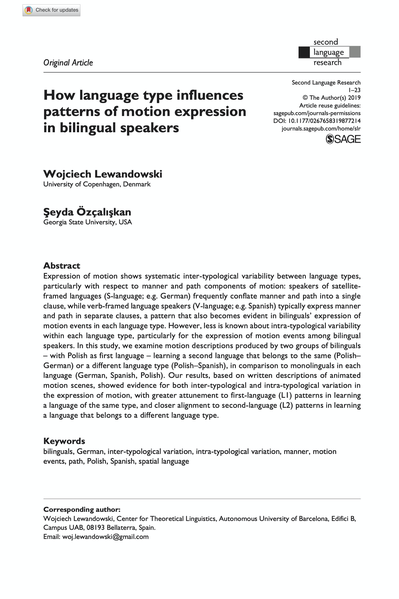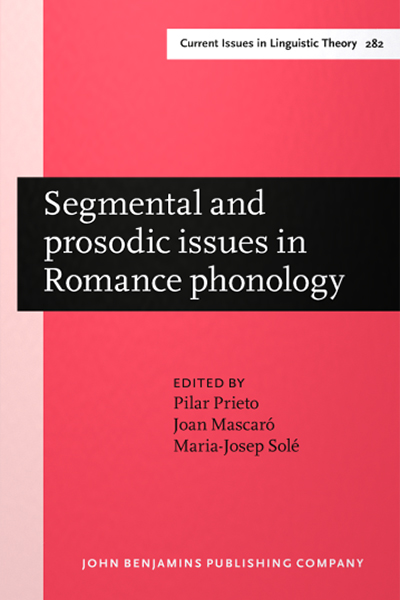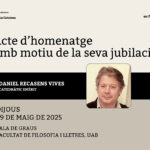8 juliol, 2019

Autors:
Wojciech Lewandowski & Şeyda Özçalışkan
Títol:
How language type influences patterns of motion expression in bilingual speakersEditorial: Second Language Research
Data de publicació: 7 d'octubre de 2019
Més informacióExpression of motion shows systematic inter-typological variability between language types, particularly with respect to manner and path components of motion: speakers of satellite-framed languages (S-language; e.g. German) frequently conflate manner and path into a single clause, while verb-framed language speakers (V-language; e.g. Spanish) typically express manner and path in separate clauses, a pattern that also becomes evident in bilinguals’ expression of motion events in each language type. However, less is known about intra-typological variability within each language type, particularly for the expression of motion events among bilingual speakers. In this study, we examine motion descriptions produced by two groups of bilinguals – with Polish as first language – learning a second language that belongs to the same (Polish–German) or a different language type (Polish–Spanish), in comparison to monolinguals in each language (German, Spanish, Polish). Our results, based on written descriptions of animated motion scenes, showed evidence for both inter-typological and intra-typological variation in the expression of motion, with greater attunement to first-language (L1) patterns in learning a language of the same type, and closer alignment to second-language (L2) patterns in learning a language that belongs to a different language type.
10 juliol, 2015

Autors:
Eulàlia Bonet, Maria-Rosa Lloret, Joan Mascaró
Títol:
Understanding Allomorphy. Perspectives from Optimality TheoryEditorial: Equinox Publishing
Data de publicació: 2015
Pàgines: 418ISBN13: 9781845532970
Més informacióThis volume is a collection of original contributions to the study of lexical allomorphy, with a focus on Optimality Theory’s distinctive take on this topic. The chapters provide an up-to-date perspective on the advances in our understanding of allomorphy which Optimality Theory has been able to secure (in comparison with rule-based Generative Phonology). They also consider a number of important allomorphy questions which Optimality Theory has helped raise and address (e.g. the nature of inputs, the role of paradigms, the interaction of phonology with other modules of grammar, lexical storage vs computation, degrees of phonological (ir)regularity, subcategorization vs markedness).
The contributors form an international array of linguists from North America and Europe. A broad variety of languages serve as the empirical base for the volume, either in detailed case studies (e.g. Burushaski, Catalan, English, French, Italian, Moroccan Arabic, Sahaptin) or in encompassing typological surveys.
The volume is aimed at professional linguists with an interest in phonology, morphology, and the lexicon. With its broad coverage of allomorphy issues, the book’s content will also lend itself to courses in phonology and morphology for advanced undergraduates and graduate students.
19 juny, 2002

Autors:
Joan Solà (Dir.), Maria-Rosa Lloret (Dir.), Joan Mascaró (Dir.) i Manuel Pérez Saldanya (Dir.)
Títol:
Gramàtica del català contemporaniEditorial: Editorial Empúries
Data de publicació: 2002-2008
Pàgines: 3616ISBN13: 978-84-9787-312-3
Més informacióEn el camp gramatical, com en altres camps, de vegades resulta difícil obtenir una producció compensada: o sigui, distingir de forma adequada els esforços que els professionals dediquen a fins diferents: a la investigació especificada i a la divulgació o a l'aplicació, a la descripció i a la teoria, a les monografies i a les obre generals o de síntesi. Aquesta obra respon a la necessitat d'ajudar a solucionar aquesta descompensació.
Una mancança recurrent en el cas de la llengua catalana han estat les obres generals de consulta o de síntesi. En moltes de les disciplines que conformen els estudis sobre el català no existeix una obra general d'aquesta mena, o bé és massa antiga, o encara no està enllestida, o no és prou satisfactòria.
En part, aquesta situació és ben explicable: fer una obra general de sintaxi, de gramàtica històrica, de dialectologia, etc. no consisteix simplement a aplegar informació d'altres autors, filtrar-la i ordenar-la -una feina que ja de per si no resulta trivial-, sinó que obliga a omplir moltes llacunes, perquè una obra general d'aquesta mena ha de ser mínimament homogènia i completa.
19 juny, 2007

Autors:
Pilar Prieto, Joan Mascaró, Maria-Josep Solé
Títol:
Segmental and prosodic issues in Romance phonologyEditorial: John Benjamins Publishing Company
Data de publicació: 2007
Pàgines: 262ISBN13: 9789027247971
Més informacióThis volume is a collection of cutting-edge research papers written by well-known researchers in the field of Romance phonetics and phonology. An important goal of this book is to bridge the gap between traditional Romance linguistics — with its long and rich tradition in data collection, cross-language comparison, and phonetic variation — and laboratory phonology work. The book is organized around three main themes: segmental processes, prosody, and the acquisition of segments and prosody.
The various articles provide new empirical data on production, perception, sound change, first and second language learning, rhythm and intonation, presenting a state-of-the-art overview of research in laboratory phonology centred on Romance languages. The Romance data are used to test the predictions of a number of theoretical frameworks such as gestural phonology, exemplar models, generative phonology and optimality theory.
The book will constitute a useful companion volume for phoneticians, phonologists and researchers investigating sound structure in Romance languages, and will serve to generate further interest in laboratory phonology.
12 setembre, 2019

Autors:
Joan Mascaró
Títol:
On the Lack of Evidence for Nonmyopic HarmonyEditorial: Linguistic Inquiry, vol.50(4). MIT Press
Data de publicació: Tardor de 2019
ISBN13: E-ISSN: 1530-9150
Més informació
One important property that has been attributed to unbounded spreading is myopia (spreading from T to U is independent of whether spreading can proceed into Z, where U is located between T and Z). Walker (Linguistic Inquiry 4.1, 2010) claims that metaphony in two Italo-Romance dialects, Grado and Central Veneto, does not obey myopia. My paper examines the evidence presented, as well as additional evidence. The evidence shows that in early 20th century Grado harmony is myopic, while in Central Veneto and the more recent variety of Grado there is no evidence in favor of non-myopic spreading. I conclude that the generalization that all attested unbounded spreading processes obey myopia still holds, and in particular that Romance metaphony is myopic. The paper concludes with a brief discussion of the problem of the quality of linguistic data.








